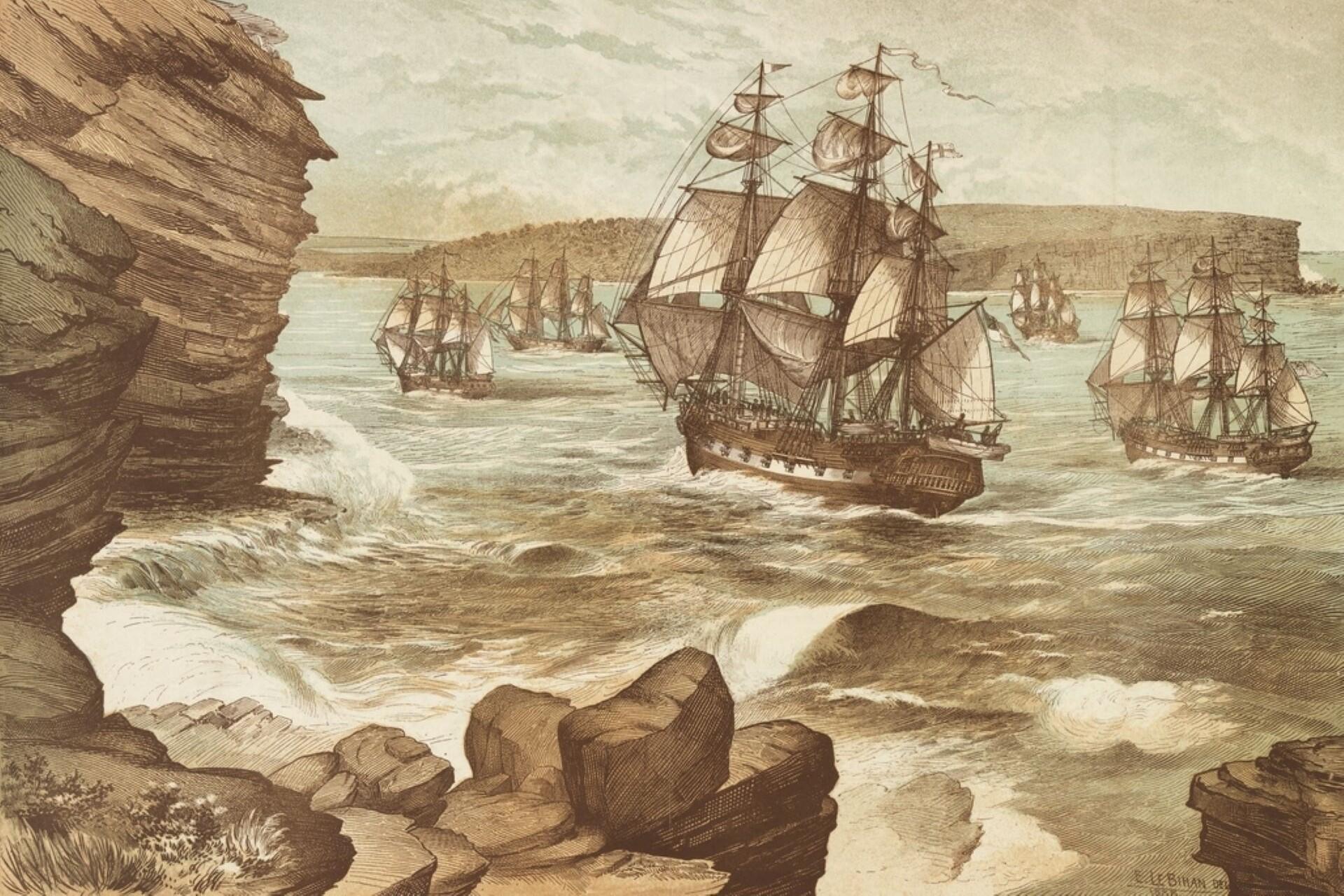The First Fleet's journey from England to Australia in 1787-1788 was the start of British colonisation in Australia. It turned New South Wales from an isolated penal outpost to a new colonial society. From 1788 to 1850, thousands of convicts and free settlers arrived in Australia, bringing with them severe consequences for the Aboriginal peoples in Australia, whose lands, resources, and ways of life were disrupted. Here, we're exploring the early colonisation of Australia and what it meant for the people already living there.

Arrival of the First Fleet in Australia
The First Fleet left England on 13 May 1787. Under the command of Captain Arthur Phillip, they were tasked with establishing a penal colony in New South Wales. 11 ships, including the flagship Sirius, the supply ship Supply, and nine transports with over 700 convicts, marines, officials, and free people, embarked on a voyage of over 24,000 kilometres.
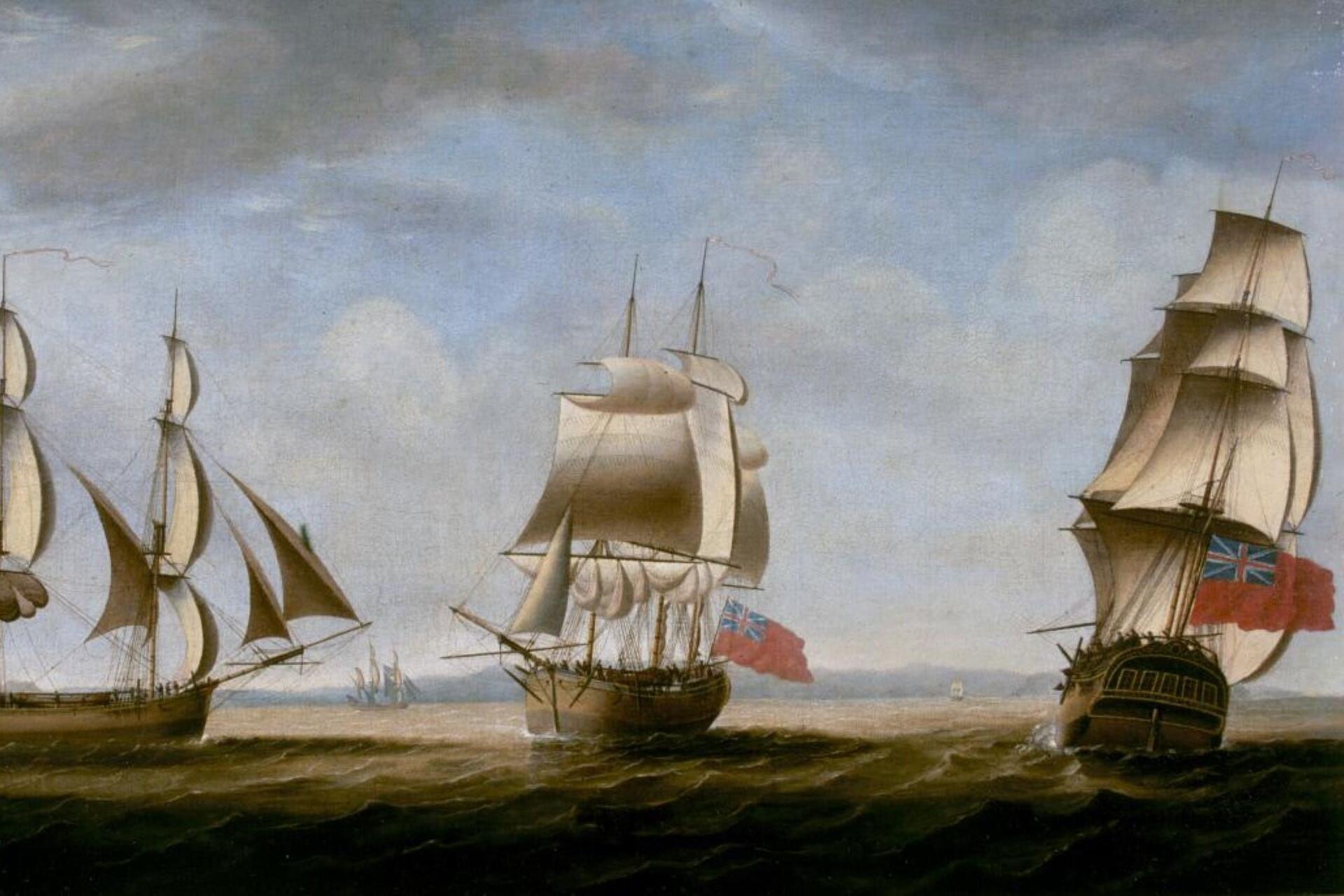
After nearly eight months at sea, the fleet first arrived at Botany Bay in January 1788, a location recommended by Captain James Cook. However, Governor Phillip decided that Botany Bay was unsuitable for permanent settlement due to its poor soil, limited freshwater, and exposure to the elements. On 26 January 1788, he led the fleet north to Port Jackson, anchoring in Sydney Cove.
The official foundation of the colony took place here. This date is now remembered as Australia's National Day and the beginning of British colonisation on the continent. A moment that would set the stage for both the expansion of the penal settlement and the disruption of Aboriginal societies.
Eleven ships departed Portsmouth on 13 May 1787, carrying around 1,420 people, including over 700 convicts, marines, officials, and free settlers. After travelling more than 24,000 km over ~250 days, they anchored at Botany Bay in January 1788.
Governor Arthur Phillip and the Foundations of the Colony
As the first Governor of New South Wales, Arthur Phillip had the challenge of building a functioning settlement in an unfamiliar land. The British government tasked him to oversee both convicts and free settlers, having to establish order, ensure food supplies, and attempt to cooperate with local Aboriginal people. Through his journals and official records, now housed in the State Library of New South Wales, we see a leader who balances strict discipline with pragmatic decision-making.
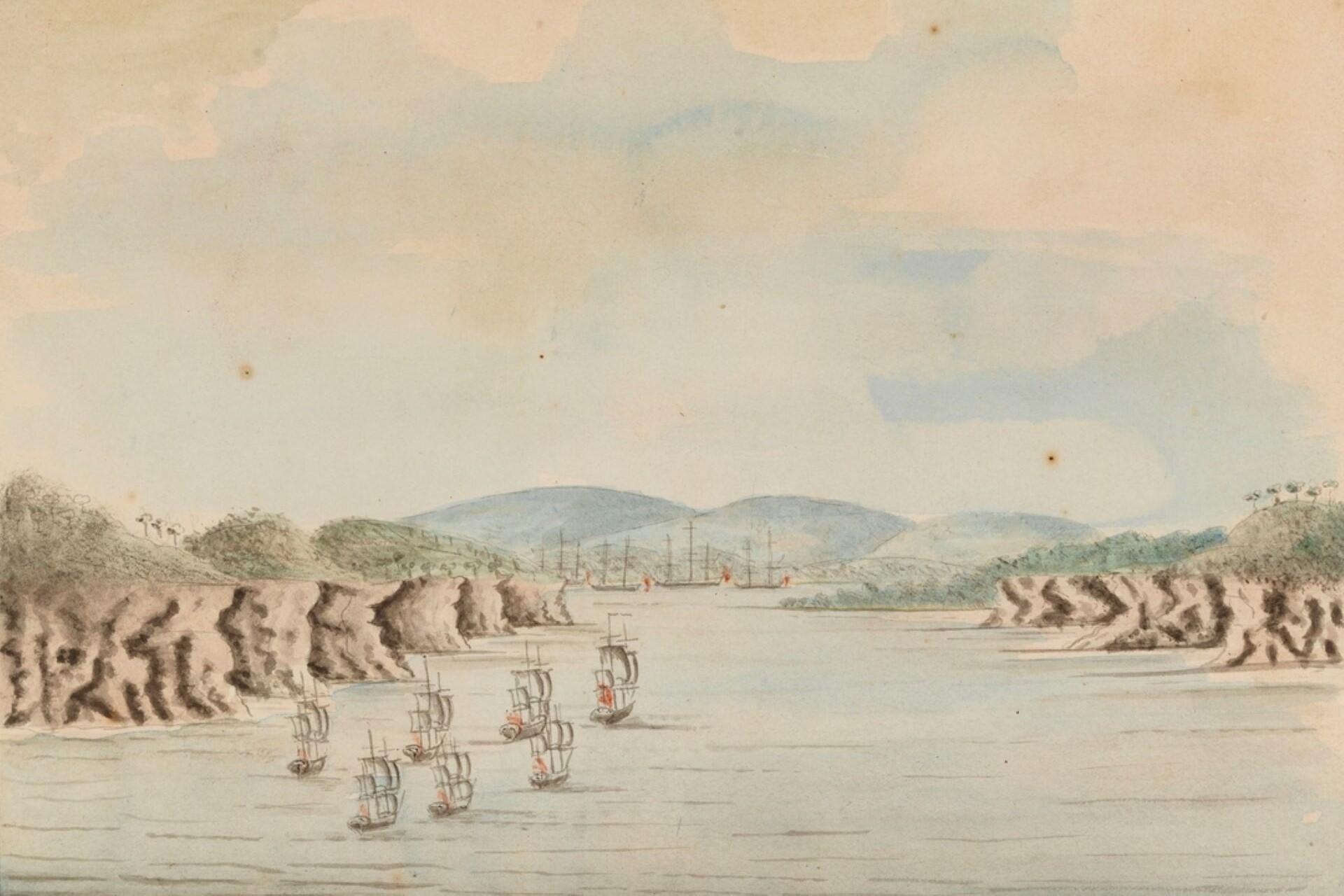
The early years were ones of scarcity. The colony had to rely heavily on the small stores brought by the First Fleet ships, and farming efforts around Sydney Cove were hampered by poor soil. The Governor ordered expeditions to more fertile areas, such as Parramatta. He promoted fishing, hunting, and careful rationing to prevent starvation during the colony's early years.
Phillip attempted to foster peaceful relations with the Eora nation. He would occasionally invite Aboriginal leaders to Sydney to promote mutual exchange. However, misunderstandings, clashes over land, and the growing pressure of convict expansion beyond the Port Jackson area meant relations could be with mixed success.
Phillip's leadership established the framework for colonial administration, law enforcement, and resource management, shaping Australia's history going forward.
Life in the Penal Settlement
Life was tough in the penal settlement. Given that the majority of the population were convicts from England and other parts of the British Empire, things were highly regimented. Sentenced to serve their terms far from home, they were put to clearing land, constructing buildings, planting crops, and unloading ships arriving with supplies.
The days were long and conditions were difficult, especially in the earliest years. Survival wasn't guaranteed due to food shortages and limited resources, and times were tough. Remember, this was some time before the gold rush that turned Australia's young towns into prosperous cities and ports.
The penal system was built on strict discipline. Punishments ranged from extra labour to floggings for theft, insubordination, or attempting to escape. Some convict labour was used for public works, while others were assigned to free settlers or military officers. This created a system of dependence and hierarchy within the colony. However, some convicts earned pardons or tickets-of-leave, which allowed them to start new lives as free people in Australia.
Basic social structures were established in the colony through religion and education, with chaplains like the Reverend Richard Johnson playing their role in shaping these social structures.

Convict Transportation and Expansion
From 1788 until the mid-19th century, convict transportation was a key factor in the growth of the colony in New South Wales. The First Fleet was followed by successive fleets of ships carrying thousands of convicts; men, women, and occasionally children. Coming from England and other British territories, the voyage to Australia was long and dangerous and disease, poor rations, and cramped conditions meant that there were often deaths at sea. However, the steady arrival of labourers meant that early colonies had the workforce needed for farming, building, and exploration.
Free settlers arrived alongside transported convicts and new settlements were established beyond Sydney. Agricultural expansion took place in the Parramatta and Hawkesbury River Regions. Exploratory journeys charted routes into the Blue Mountains and the interior.
Governor Phillip's successors, such as John Hunter, Philip Gidley King, and William Bligh, all oversaw the expansion of colonial influence, utilising convict labour and free migrants to consolidate their control over the new lands, much like the immigration policy of postwar Australia sought to do with willing migrant participants.
By the early 19th century, transportation was extended to the other states and territories. Norfolk Island became a notorious penal colony. Van Diemen's Land (Tasmania) was another key penal colony. These settlements were used to punish re-offenders and serve as bases for further exploration and exploitation of the natural resources.
Transportation to New South Wales officially ended in 1840, but the system continued elsewhere in Australia until 1868. This left a lasting impact on the population, economy, and history of Australia.
Relations with Aboriginal Peoples and Resistance
As you may be aware, the Aboriginal peoples of Australia have been there for tens of thousands of years. Aboriginal history in Australia dates back long before the arrival of the First Fleet, but from the moment the First Fleet arrived in January 1788, interactions became increasingly complex.
Governor Arthur Phillip initially attempted to make peaceful contact with the Eora people. Leaders such as Bennelong were invited into the colony and cultural exchange was actively encouraged. However, the rapid spread of the settlement, land seizures, and depletion of traditional resources did nothing to help relations.
New diseases like smallpox killed large numbers of Aboriginal men, women, and children during the first two years of colonisation. When settlers and convicts expanded into the Hawkesbury and Nepean regions, resistance movements emerged. Leaders like Pemulwuy of the Bidjigal clan led campaigns against farms, supply routes, and outposts. The British responded with military patrols and punitive expeditions.
A disease outbreak (likely smallpox or chickenpox) swept through Sydney’s First Nations communities in April 1789, killing up to 70% of local Aboriginal people, while virtually sparing the colonists.
Beyond New South Wales, similar patterns of dispossession and violence were observed in the new colonies of Van Diemen's Land, the Hunter Valley, and along the south-east coast. Frontier conflicts went unrecorded in official government journals, but oral histories and historical studies confirm Aboriginal resistance.
Frontier Conflict and Land Dispossession
With the expansion of the British colony in New South Wales beyond Sydney Cove and Port Jackson, free settlers and convicts moved into fertile river valleys and inland plains, often in direct violation of Aboriginal territorial boundaries.
to various Australian colonies.
The expansion caused decades of frontier conflict, skirmishes, raids, and massacres across the state and beyond. The violence followed the path of colonial agriculture and pastoralism into the Hunter Valley, the Hawkesbury, and further south and west.
The British secured land using official military expeditions and informal settler militias, which led to incidents like the Appin massacre (1816) in New South Wales and similar events in outlying districts. The seizure of land disrupted the Aboriginal spiritual and cultural connection to Country, and many Aboriginal people ended up having to rely on colonial rations or dangerous resistance to survive.
Frontier conflict was a recurring feature of early Australian history. However, although it was documented in historical records, such as journals kept by officers, missionary reports, and later government inquiries, it was regularly omitted from official narratives, something that later civil rights movements would seek to rectify.
The pattern of dispossession spread to Van Diemen's Land, with violent clashes and forced removals to Flinders Island. Events like these permanently altered the demographics and culture of the regions and are remembered as times of profound loss for Aboriginal nations.
Expansion to Van Diemen’s Land and the NSW Interior
British expansion in the early 19th century went from the colony in New South Wales beyond Sydney Cove. Explorers such as Gregory Blaxland, William Lawson, and William Charles Wentworth crossed the Blue Mountains in 1813, which enabled both free settlers and convicts to establish farms and grazing lands along the Macquarie and Lachlan rivers.
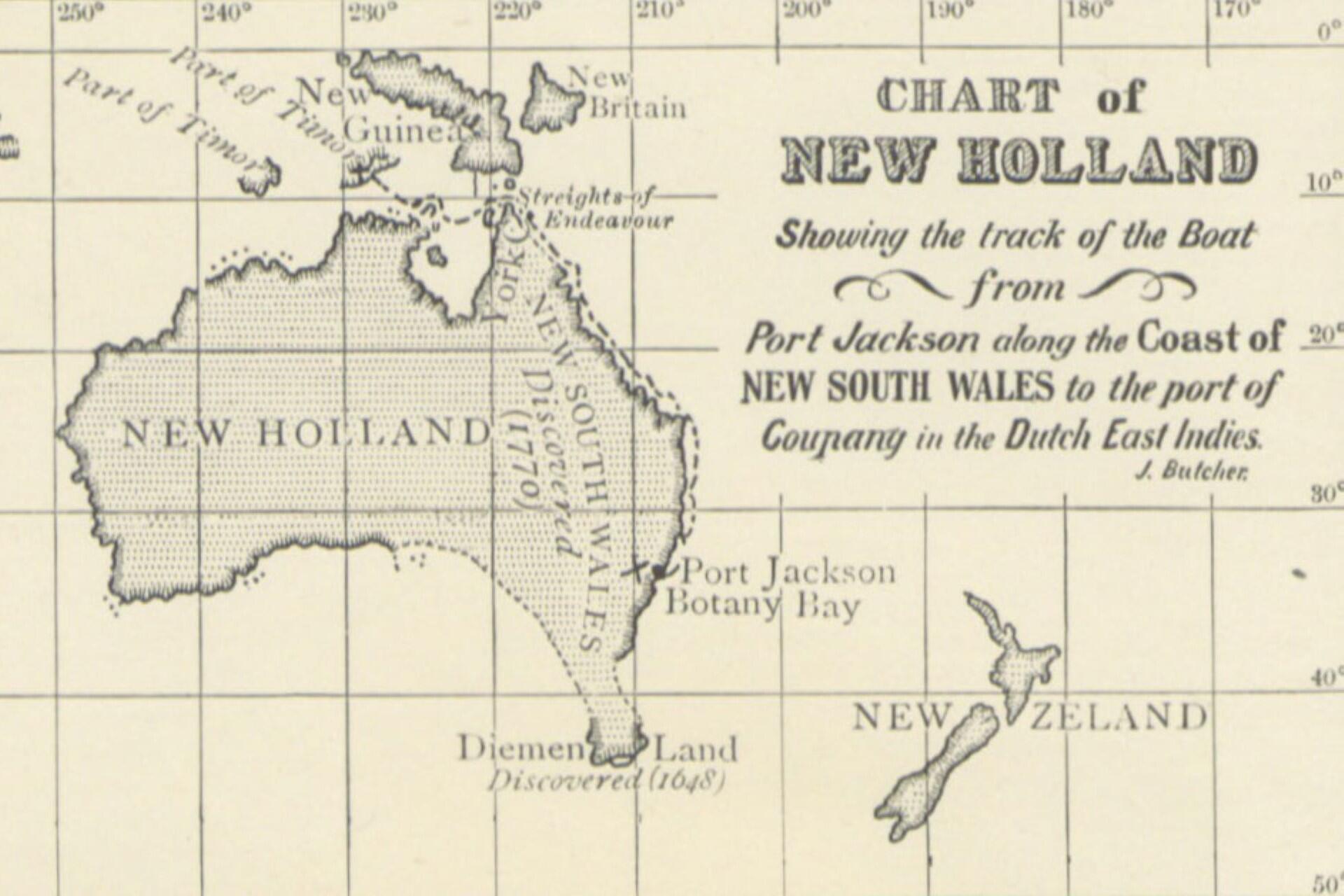
Van Diemen's Land (now Tasmania) was formally settled in 1803, securing the island from possible French claims and establishing it as another penal colony. The settlement became infamous for its strict penal system under governors like David Collins and George Arthur and the violent frontier conflict with local Aboriginal peoples. The "Black War" of the 1820s and 1830s involved military forces and armed settlers and a significant loss of life. Surviving Aborigines were removed to Flinders Island. This is unlike other wars that Australia fought, where Aboriginal peoples fought for Australia, despite not having the same rights as many of their comrades upon their return.
Remote settlements, such as Norfolk Island, were used as secondary punishment for reoffending convicts, and by 1850, colonisation of Australia had reached a point where several states and territories were emerging from the administrative control of New South Wales.
1787
First Fleet Departs England
Eleven ships set sail from Portsmouth on 13 May 1787, carrying the foundation of the New South Wales penal colony.
1789
Catastrophic Disease Outbreak
A smallpox, or possibly chickenpox, epidemic ravaged Sydney’s First Nations communities, killing up to 70% of the local population.
1868
End of Penal Transportation
The last convict ship arrived in Western Australia in 1868, marking the close of Australia’s transportation era.
Legacy of the First Fleet and Early Colonisation
The First Fleet's arrival in January 1788 was the beginning of a new chapter in Australian history, but the rapid colonial growth and the transformation of land had consequences for both Aboriginal peoples and settlers.
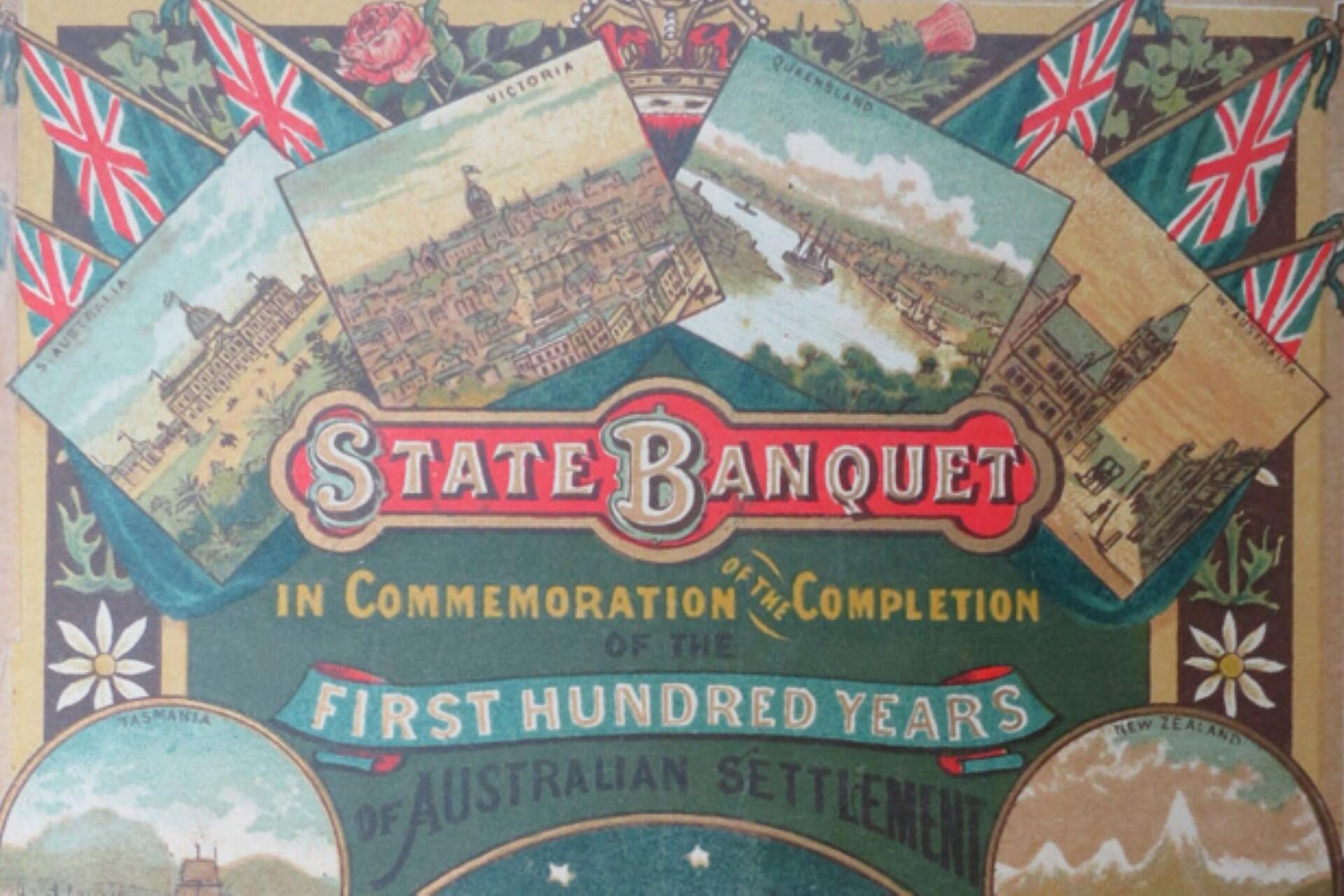
Early decades saw the creation of administrative frameworks, the development of agriculture and trade, and the construction of infrastructure, but it also came with devastating frontier conflict, dispossession, and demographic collapse of Indigenous communities.
Sites like Botany Bay, Port Jackson, and Norfolk Island are significant heritage locations with artefacts, journals, and official records telling the story of what happened. The First Fleet is not just the starting point of British colonisation in Australia, but it's also the turning point when the oldest continuous culture on Earth faced one of its biggest challenges, one which can still be felt over two centuries later.

